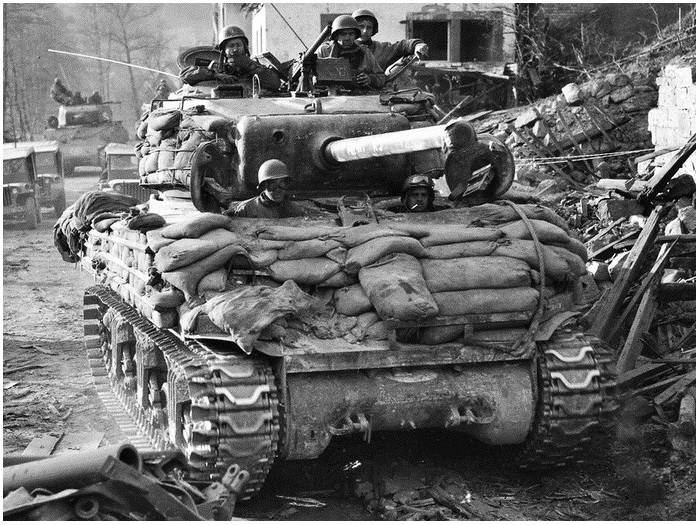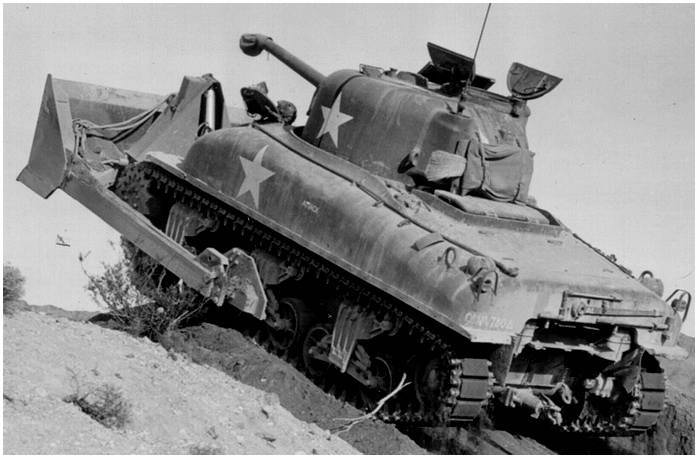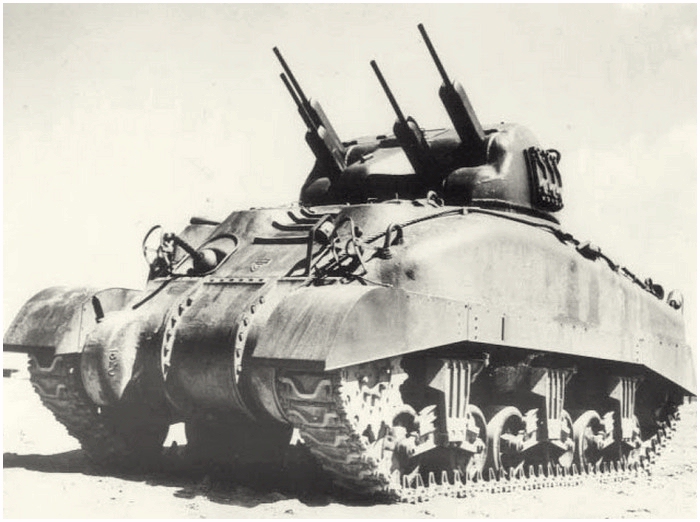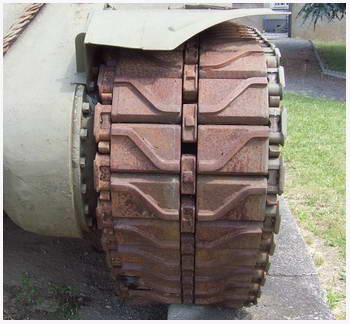|
The M4 was first mainly an anti-tank weapon and a support vehicle for the infantry, later on it was used for several other duties. Famous are the adaptations made for the D-Day landing on June 6th, 1944 in Normandy, such as the DD-tanks, mine sweepers and bulldozers. But there were more adaptations. A couple is shown on the coming page. But first on this page; how the M4 was handling itself on the battlefield.
With a production of almost 55.000 M4’s, the greatest production in the history of armored vehicles, I have always been amazed that the British gave the M4 the name, ‘Sherman’. It is a word close to the English word ‘German’. Is there prove that some Shermans were hit by friendly fire? Because of bad communication I can imagine when there was a ‘Sherman tank’ approaching and it was told to a ‘friendly gunner’, he could easily mistake it for a ‘German tank’.

The M4 was far from ideal in the field. The armor was thin and the guns of 75mm and 76mm were not heavy enough to penetrate the German Panther and Tiger tank. The British 17pdr in the Firefly was the only cannon that could stop these monsters. The thin armor was evident during 'Operation Goodwood' on 18 July 1944, when just four German 88mm guns destroyed 40 Shermans. That first day over 200 British and Canadian tanks were lost to German fire. This was the day that the Sherman got its doubtful nicknames 'Tommy-cooker' or 'Ronson-lighter' (after the famous cigarette lighter)

Only the enormous numbers of Shermans, better maintenance and logistics (read fuel and ammo supply) was something the Germans were not able to match. Also to bring new developments into the basis of the M4 made the Sherman better. 
In many publications you find reference that the high profile of the M4 made it an easy target. This I doubt. Below you find the measurements between the Shermans height, 2.96 meters, against their German counterparts. It shows that even the Panzerkampfwagen V Panther is a few centimeters higher then the M4! But the misunderstanding is understandable, the M4 is rather short and compact in it’s length, 5.86 meters. The German Panther had a length of 8.86 meters, three meters more! And what about the enormous size of the 68 tons heavy Königstiger with a height of 3.10 meters and an impressive length of 10.28 meters?! In comparison the German tanks ‘looks’ lower, but as a matter of fact, they are not. The power of the M4 was his compact size, good speed and maneuverability.

A great invention was the so called DD-tank (Duplex-Drive). These tanks had a canvas screen around the hull of the tank to keep it afloat. The screen was kept in place by inflatable tubes and a metal frame. Propelled forward by two screws they would head for the coast. That was the purpose, however, during the landings on June 6th the sea was too rough to use the DD's to the fullest. At Omaha Beach the DD's were dropped in the sea much to far from the coast and most of them were lost in the waves. Different types of the M4 were used for DD tanks. More on this subject, see ‘Hobarts Funnies’. 
(notice the edge for the canvas screen) Another of the variants that was based on the M4, was the Sherman ‘Crab’ mine sweeper. This British invention on a Sherman tank belonged to one of the ‘Hobarts Funnies’. The Americans had also an anti-mine M4. This was a vehicle with two large heavy weight wheels in front of its tracks. But the tanks were difficult to handle in muddy terrain. The US Army used later the British ‘Crab’ as their standard mine sweeper. CLICK HERE 
To clear the first obstacles on the beaches that could clog up the first waves during the landings, like the filling in of bomb craters, to push a breakthrough at barricades, a M4 was adapted with a shuffle from a bulldozer. These so called 'Tankdozer' became very successful. At first the use was troublesome when of the 16 deployed at Omaha Beach, only 6 were useable (one had lost it's shuffle). In the battle through the 'bocage' in Normandy, they broke through the infamous hedges, in Caen and other places they cleared the streets of rubble after the bombardments 
The battle in the hedges of Normandy was taking a heavy toll on men and vehicles. To break through the centuries old high walls it asked for a lot of violence. To roll over the wall, it exposed the vulnerable underside of the Sherman, asking for a German anti-tank weapon to hit it. A lot of thinking went in a way to make a smooth breakthrough. Some M4's were given a long steel stake to drive a hole in the wall where explosives could be detonated in to create a large breach. But it stayed difficult. 
Lieutenant Charles Green, a tanker of the 29th Division, used old curled rail tracks that Rommel had used as beach obstacles. These were placed at the front of a Sherman, to cut up the old walls. Sergeant Curtis Culin, of the 2nd Armored Division, developed a similar solution by welding German roadblock ironworks at the front of M4's to be used as hedgerow cutters. The Cullin solution became known as the 'Rhino' tank (rhinoceros).

There were more variations used on the M4 chassis, like the recovery vehicles. The recovery vehicles had one thing in common, they had no turret. The M32 Tank Recovery Vehicle was the most used TRV. It had an 18 feet A-frame jib and a strong winch that was housed in the spot of the deleted turret. The M32 was a development out of the T5 and T5E1. During the Korean War the urge for a recovery vehicle was in demand. And, so an M4A3 was converted to an M74 by Bowen McLaughlin-York during a period from February 1954 until October 1955. Rock Island Arsenal rebuilt well into 1958 sixty M32B3's to the TRV M74.

Another model, developed by the British, was the Sherman BARV (Beach Armoured Recovery Vehicle). These had no heavy winch or jib. It was used to recover vehicles by towing or pushing (on the front it had two heavy beams). The BARV had a high construction so it could move in relative high water.

Beside the turret-less Shermans, there were enough versions that kept there turrets, and sometimes given an extra function. Like the flame thrower or the version for launching rockets. Examples of the rocket version were the T34 'Callilope' (with 60 rockets on top of the turret), the T40 'Wizzbang' (20 even so on top of the turret) and the T99 (22 rockets on the both sides of the turret). To elevate the rocketpack, it was coupled to the barrel of the cannon with a steel rod. werd het kanon van de Sherman, dat met een stang aan de rakettenbak was bevestigd, omhoog of omlaag gebracht.

another crew (below) prepare a T34 'Calliope' for a launch.


A fascinating version of an M4 was the 'Skink'. To counter the threat of the Lufwaffe during and after the landing on D-Day, a potent anti-aircraft weapon was needed. One of these ideas was to give a Sherman, in this case a Canadian M4 'Grizzly I', four Hispano-Suiza 20mm cannons. Because these were needed in the aircraft industry, the choice was made to use the Polsten (an Oerlikon based design). A prototype was built and tested. The High Explosive Incendiary Tracer (HEIT) ammo was very effective and a production was started.

But the Luftwaffe threat was dwindling and the production was stopped after three produced vehicles. One however saw action in Europe in the hands of the 6th Armoured Regiment (CAR) and later with the 22nd CAR. It was thrown in to support the infantry. The weapon was a great success. When the guns blasted away on the buildings where the Germans were hiding, one such a burst was enough to drive them out and surrender. Today only a few turrets remain of this fascinating vehicle.

was also very effective against ground targets A new design with the chassis of a M4A2 as a basis, was the M10 and the M36 tank destroyer.
To read more about these vehicles, click on the link below.
HVSS en TRACKS A new design on the M4 was the introduction of a new suspension system, the Horizontal Volute Spring Suspension (HVSS). Designed to improve the shock absorbing action and maintenance, the tracks were widened from 16½ inch (41 cm) to 23 inch (57.5 cm). The original bogie consisted in two lower track wheels and one track return wheel on top, the HVSS had four lower track wheels. The top return wheels were built on to the chassis. M4's with the HVSS system were called 'Easy Eight's' after the test vehicles, E8.
 
For the M4 were four types of tracks available. The first models were mainly delivered with the rubber blocks as runners. Other tracks were complete steel tracks without any rubber. These were better in slippery conditions and saved rubber.
 
To have some more grip with rubber or steel tracks, the 'chevron' was introduced. For extra grip in muddy and snowy conditions the width of the track could be enlarged by a quarter when adding so called 'extended end connectors'. This could be done in the field when the occasion arrived. Another name for the extended end connectors was 'duckbills'.
 
and the later version of wider tracks for the HVSS systeem The ‘extended end connectors’ were a good solution for more grip. For still more grip on softer ground, the so called ‘grousers’ were developed. These long pieces of metal could have a length of 32.5 inch, to 37 inches. There were even grousers of 39 inches in length. After a 1000 miles they had to be replaced.

Below is a picture of an early preserved M4A1. It has not the standard M4 tracks. These are the so called Canadian Dry Pin (CDP) tracks that were used on some types of the RAM.

My preceding words mention only the top layers of the M4 and her history.
Many books are written about the M4, and rightly so.
But unfortunately not a lot about the crews who drove this cold steel vehicle.
My advice to you is to look for the book 'Barbara'. The book is a testimony
to every tank crew of the 2nd World War. Strap yourself in the hectic claustrophobic
fears and the hot stench of the cramped Sherman.
CLICK HERE
I leave you with the following thought; when you pass a monument that consists of a M4 Sherman, I like you to remember the three men in the turret and the two in the front. Picture yourself at a terrain that is difficult to survey, explosions, yelling, anger, loud engine noise, creaking and grinding tracks, a little space filled with sweat and smoke,… the fear for that German grenade with your name on it, that could end your struggle for survival. But you still you do the job you are trained to do, come what may. One such monument, pictured below at Monte Cassino, had such a unnamed crew. I mention the M4 Sherman a lot on my pages, because the M4 with her gallant crew was a little braveheart.

|






